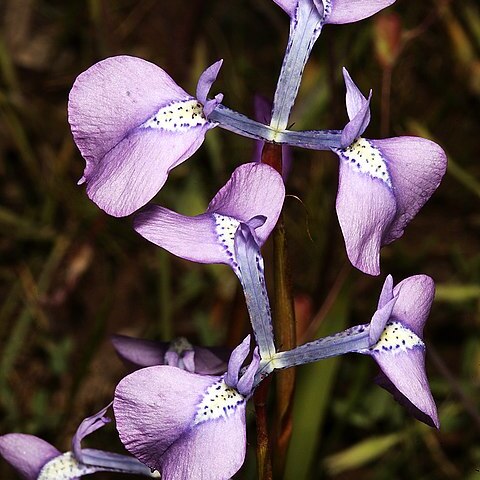Plants (140-)250-450 mm high. Corm mostly 8-15 mm diam., without cormlets at base; tunics of moderately coarse, wiry, usually dark grey fibres. Stem simple or 1-or 2(6)-branched, sheathing leaves with dry, brown attenuate apices, mostly 45-60 mm long. Foliage leaf solitary (rarely 2 in subsp. violacea), leathery, narrowly channelled, C-or V-shaped in section, up to 5 mm wide, usually exceeding stem and trailing distally. Rhipidial spathes with dry attenuate apices, inner 35-65(-70) mm long, outer ± 1/2 as long. Flowers long-lived, pale blue, purple or violet, outer tepal limbs with nectar guides at bases triangular, either yellow edged with violet, or white-dotted with dark blue and edged with darker blue, spreading at 45º, lightly honey-scented, unscented or strongly scented of carnation (subsp. violacea); outer tepals 20-30(-32) x ± 8-13 mm, claws 9-12 mm long, limbs obovate, 11-18 mm, inner tepals hair-like to ± linear, 1-4(-6) mm long, or lacking. Filaments 4-6 mm long, united for 0.5-1.5 mm, occasionally (southern populations) ± free; anthers 4-7 mm long; pollen usually orange-red, rarely white. Ovary 4-9 mm long; style branches 9-12 mm long, crests ± linear, 5-12 mm long. Capsules ellipsoid, 8-14 mm long. Seeds ± angular, 1.0-1.3 mm long, with raised, golden-brown ridges.
More
Cormous geophyte, (10-)20-45 cm, with coarse, wiry tunic fibres. Leaf solitary (rarely 2), linear, narrowly channelled, rarely hairy beneath. Flowers blue to violet (rarely white or pale yellow), inner tepals reduced to short attenuate cusps (rarely linear and spreading distally), filaments united basally for up to 1.5 mm (rarely free), pollen usually red.
An erect slender herb. It grows 10-50 cm tall. The stem is slender and branched. The corm is round. The leaves occur singly from the base. They are smooth, flat and narrow. The flowers has a large spathe around it. The flowers are 20-35 cm long with white speckles at the centre. The fruit is a capsule. There are several angled seeds.

